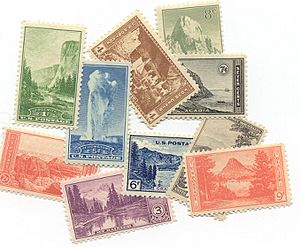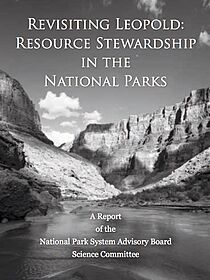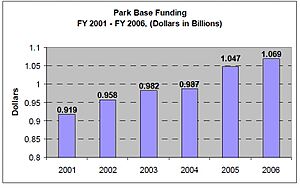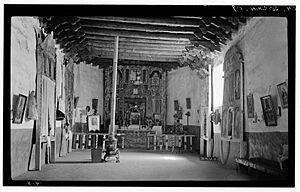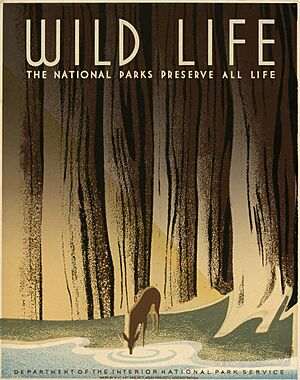National Park Service facts for kids

National Park Service arrowhead insignia
|
|

Guidon of the National Park Service
|
|
| Agency overview | |
|---|---|
| Formed | August 25, 1916 |
| Jurisdiction | United States government |
| Headquarters |
|
| Employees | About 20,000 (2022) (279,000 volunteers in 2019) |
| Annual budget | $3.265 billion (FY2022) |
| Agency executive |
|
| Parent department | Department of the Interior |
| Map | |
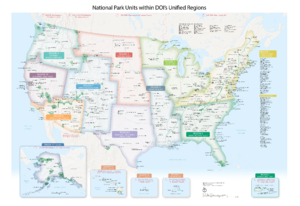 |
|
The National Park Service (NPS) is a special agency of the United States government. It works within the U.S. Department of the Interior. The NPS takes care of all national parks and most national monuments. It also looks after other natural, historical, and fun places across the country.
The United States Congress created the NPS on August 25, 1916. This happened through a law called the National Park Service Organic Act. The main office of the NPS is in Washington, D.C..
The NPS has about 20,000 employees. They work in places covering over 85 million acres (344,000 square kilometers). These places are in all 50 states, Washington D.C., and U.S. territories. In 2019, more than 279,000 people volunteered to help the NPS. The agency's job is to protect the nature and history of these places. They also make sure people can visit and enjoy them.
Contents
History of the National Park Service
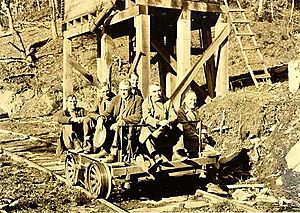
The idea of a national park might have started with artist George Catlin. In 1832, he traveled to the Dakotas. He thought that Native American ways of life, wildlife, and wild places were in danger. Catlin suggested they should be saved "in a magnificent park." This would be "A nation's Park, containing man and beast."
Yellowstone National Park became the first national park in the United States. It was created in 1872. At that time, Wyoming was a U.S. territory. So, the federal government managed Yellowstone directly. The army, including the famous African American Buffalo Soldier units, helped protect it.
A businessman and conservationist named Stephen Mather led the effort for a special agency to manage these lands. With journalist Robert Sterling Yard, Mather started a public campaign. They wrote many articles. These articles praised the beauty and history of the parks. They also talked about how parks could be used for learning, inspiration, and fun.
This campaign led to the creation of the NPS. On August 25, 1916, President Woodrow Wilson signed the National Park Service Organic Act. This law said the NPS must "conserve the scenery and the natural and historic objects and wildlife therein." It also said the NPS must "provide for the enjoyment of the same." This had to be done in a way that would keep them safe for future generations. Stephen Mather became the first director of the NPS.
On March 3, 1933, President Herbert Hoover signed a new law. This law allowed the president to move national monuments from one government department to another. Later that summer, President Franklin D. Roosevelt used this power. An NPS leader, Horace M. Albright, suggested that the NPS should manage historic American Civil War sites. Before, the War Department managed them.
President Roosevelt agreed. He issued two special orders. These orders moved all historic sites from the War Department to the NPS. They also moved national monuments managed by the Department of Agriculture. Parks in and around Washington, D.C., also moved to the NPS.
After World War II, many people visited the parks. The parks became very busy. The NPS struggled to keep up with the demands. In 1951, Conrad Wirth became the director of the NPS. He started to improve park facilities. In 1952, with President Dwight D. Eisenhower's support, Wirth began Mission 66. This was a ten-year plan to upgrade and expand park facilities. It was ready for the 50th anniversary of the Park Service. New parks were added, and existing ones were improved.
In 1966, the Park Service turned 50 years old. The focus changed. It was not just about saving beautiful scenery. It was also about making parks easy for everyone to visit. Director George Hartzog started this change. He created National Lakeshores and then National Recreation Areas.
Managing Park Resources
In 1963, a report called "Wildlife Management in the National Parks" was written. It was led by A. Starker Leopold. This report suggested ways to manage park ecosystems. It helped guide park policy for many years. It was the first clear plan for managing both visitors and nature in parks. The report said that parks should try to keep their natural look. This meant how they appeared to the first European visitors.
In 2012, a new report called "Revisiting Leopold" updated these ideas. It said that park leaders should "manage for change while confronting uncertainty." This meant using new science and tools to help the NPS manage parks better.
By 2021, a new plan was made for dealing with climate change. It is called "Resist–Accept–Direct" (RAD). This plan helps park managers make decisions as the environment changes. The three RAD options are:
- Resist: Try to keep the ecosystem as it has been.
- Accept: Let the ecosystem change on its own.
- Direct: Actively guide the ecosystem toward new, desired conditions.
This RAD framework helps the NPS and other agencies work together. It helps them think strategically about how to care for changing ecosystems.
National Park System
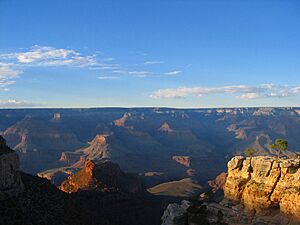
The National Park System includes all the places managed by the National Park Service. These places have many different names. The whole system is seen as a "national treasure" of the United States. Some famous national parks are even called "crown jewels."
The system covers about 85.1 million acres (344,000 square kilometers). About 2.6 million acres (10,500 square kilometers) of this is still privately owned. The largest park is Wrangell–St. Elias National Park and Preserve in Alaska. It is 13.2 million acres (53,000 square kilometers). This is more than 16% of the entire system. The smallest park is Thaddeus Kosciuszko National Memorial in Pennsylvania. It is only 0.02 acres (80 square meters).
The NPS also helps other areas that Congress has approved. These are called affiliated areas. The largest is New Jersey Pinelands National Reserve. The smallest is Benjamin Franklin National Memorial.
Laws generally cover all parts of the National Park System. But each park also has its own rules. These rules come from the laws that created them. For example, Congaree National Park is mostly a wild area with no buildings. But Yosemite National Park has a ski area and a dam. These special things are allowed because of the laws that created those parks.
How Parks Are Chosen
Most NPS units are created by a law passed by Congress. The president then signs the law. However, the Antiquities Act allows the president to create national monuments by special order. No matter how they are created, all parks must be important to the nation.
A place that might become a park should meet four standards:
- It is a great example of a certain type of natural or historical place.
- It is very valuable for showing or explaining the nation's heritage.
- It offers excellent chances for fun, public use, or scientific study.
- It is still very natural, accurate, and unspoiled.
Before a new park is created, Congress usually asks the NPS to study the area. This study checks if the place is important enough to be part of the National Park System.
Names of Park Units
The NPS uses over 20 different names for the park units it manages. Some common ones are national park and national monument.
- National parks protect important natural areas and beautiful scenery.
- National monuments protect a single special cultural or natural feature. Devils Tower National Monument was the first in 1906.
- National preserves protect certain resources. They are like national parks but allow some activities like hunting or fishing.
- National reserves are similar to national preserves. But a state or local government might manage them.
- National historic sites protect an important cultural place that is not too complex.
- National historical parks are larger areas with more complex historical topics.

- National military parks, battlefield parks, battlefield sites, and battlefields protect areas linked to military history. These names show how complex the event and site are. Many protect important Revolutionary War and Civil War battlefields.
- National memorials honor a person or event. They might not be at the exact historical spot. The Washington Monument and Lincoln Memorial are examples on the National Mall.
- National seashores and national lakeshores protect coastlines. They also allow water-based fun. Cape Hatteras National Seashore was created in 1937.
- National rivers and wild and scenic riverways protect free-flowing rivers. These rivers cannot be changed by dams or other things. Fun activities are encouraged along them.
- National recreation areas were first created around lakes made by dams. Some are now in cities, like Gateway National Recreation Area.
- The National Trails System protects long-distance paths across America. This includes National scenic trails (like the Appalachian Trail) and National historic trails (like the Trail of Tears).
Special Protected Areas
Wilderness areas are very wild and untouched lands. They are part of the National Wilderness Preservation System. This system was created in 1964. It protects millions of acres of land.
Marine Protected Areas (MPAs) are ocean areas protected by the government. The NPS has 19 park units that are also MPAs.
Park Visitors
The National Park System had over 325 million visits in 2023. In 2024, the NPS reported a record 331.9 million visits.
The 10 most-visited parks handle about 30% of all visits. The top 10% of parks (43 parks) handle over 64% of all visits. This means the other 380+ parks share the remaining 36% of visits.
| Park | Rank (2024) | Visits (2024) |
|---|---|---|
| Golden Gate National Recreation Area |
|
17,187,508
|
| Blue Ridge Parkway |
|
16,733,639
|
| Great Smoky Mountains National Park |
|
12,191,834
|
| Gateway National Recreation Area |
|
8,929,035
|
| Lincoln Memorial |
|
8,479,349
|
| Gulf Islands National Seashore |
|
7,801,176
|
| Natchez Trace Parkway |
|
7,364,833
|
| George Washington Memorial Parkway |
|
6,782,717
|
| Lake Mead National Recreation Area |
|
6,412,854
|
| Vietnam Veterans Memorial |
|
5,295,711
|
Park Fees
Many National Park System areas do not charge entrance fees. They are supported by taxes. However, some very popular parks do charge fees. These fees vary and are usually for 7 days. The America the Beautiful Pass lets the holder and up to 3 other adults enter for free. Children aged 15 and younger are usually free. Annual passes for single parks are also available.
Overnight Stays
Over 15 million visitors stayed overnight in national park units during 2015. Most of them were tent campers. Many also stayed in lodges or RVs.
NPS Budget
In 2019, the NPS had a budget of $4.085 billion. It also had an estimated $12 billion in needed repairs. On August 4, 2020, the Great American Outdoors Act became law. This law helped reduce the repair backlog by $9.5 billion over five years. As of 2022, the NPS had the largest budget of any part of the Department of the Interior.
The NPS budget has two main parts: discretionary and mandatory spending. Discretionary spending includes the daily operations of the parks. It also covers special projects.
How Money is Spent
The money for park operations (ONPS) pays for everything the parks do. The United States Park Police funds cover law enforcement in some large parks. These include Gateway National Recreation Area and the National Mall. Other programs support outdoor activities in states and local areas.
The ONPS budget is split into six main areas:
- Resource stewardship: This money helps restore, protect, and maintain natural and cultural resources. Staff include biologists, archaeologists, and preservation specialists.
- Visitor services: These funds are for public programs and education. Park rangers give talks and tours. Media specialists create exhibits and brochures.
- Park protection: This covers staff who respond to emergencies (like crimes or rescues). They also protect park resources from damage. This includes law enforcement rangers, park police, and lifeguards.
- Facility maintenance and operations: This is the cost of keeping park buildings, roads, and trails working. Staff include electricians, plumbers, and trail crews.
- Park support: This staff handles the daily needs of the parks. They include human resources, budget managers, and IT specialists.
- External administrative costs: These are payments to outside groups that help the NPS operate. This includes rent for office space.
| Functional area | FY 2010 (in thousands) | % of total |
|---|---|---|
| Resource stewardship |
$347,328
|
15.3%
|
| Visitor services |
$247,386
|
10.9%
|
| Park protection |
$368,698
|
16.3%
|
| Facility maintenance and operations |
$705,220
|
31.1%
|
| Park support |
$441,854
|
19.5%
|
| External administrative costs |
$155,530
|
6.9%
|
| Total (2010) |
$2,266,016
|
Other Funding Sources
The Land and Water Conservation Fund (LWCF) helps buy important lands to protect existing public lands. It also gives money to states and local areas. This helps them protect Civil War battlefields and other lands.
The Historic Preservation Fund (HPF) was set up in 1977. It helps preserve historic places. This money comes from oil and gas lease revenues, not taxes. It gives money to states, tribes, and local governments.
Economic Benefits
The NPS helps the economy at local, state, and national levels. A 2011 report said that for every $1 invested in the NPS, the public gets $4 back in economic value. In 2011, national parks created $30.1 billion in economic activity. They also supported 252,000 jobs across the country.
A 2017 study found that 331 million park visitors spent $18.2 billion in areas near National Parks. This spending supported 306,000 jobs.
Park Services and Businesses
The NPS works with private businesses to offer fun activities and places to stay in parks. These are called concession contracts. For example, you can stay at the Wawona Hotel in Yosemite National Park.
Some companies that work with the NPS include:
- Delaware North Corporation at Yosemite National Park, Yellowstone National Park, and Grand Canyon National Park.
- Forever Resorts at Big Bend National Park, Blue Ridge Parkway, and many others.
- Xanterra Parks & Resorts at Bryce Canyon National Park, Crater Lake National Park, and more.
Trademark Dispute
In 2015, Delaware North sued the NPS. They argued that the NPS had undervalued the names of famous Yosemite places. These names included "Ahwahnee" and "Curry Village." Delaware North said the names were worth $51 million. The NPS thought they were worth much less.
To avoid paying the high amount, the NPS decided to rename the landmarks in 2016. For example, the Ahwahnee Hotel became The Majestic Yosemite Hotel. Many people were upset about this. The names were restored in 2019 after the problem was solved.
NPS Offices
The main NPS office is in the Main Interior Building in Washington, D.C.. This office has eleven main departments. These departments handle things like business, staff, information, cultural resources, and visitor safety.
There are also regional offices in cities like Anchorage, Atlanta, Lakewood, CO (near Denver), Omaha, NE, Philadelphia, San Francisco, and Seattle.
The NPS is part of the U.S. Department of the Interior. The NPS director is chosen by the president and approved by the United States Senate. This director leads the agency with the help of other senior leaders.
Staff and Volunteers
NPS Directors


Employees
In the mid-1950s, park rangers were the main employees. They had many jobs. They cleaned, fought fires, managed traffic, and helped visitors. They also did rescues and investigated crimes.
Today, the NPS has many types of workers:
- National Park Service Rangers: These include interpreters (who teach visitors) and law enforcement rangers (who enforce laws).
- Park management: Superintendents and their deputies lead the parks.
- United States Park Police: These are police officers who work in certain park areas.
- Emergency management: These include medical providers and search and rescue specialists.
- Maintenance: This team keeps buildings, roads, and trails in good shape. They include carpenters, plumbers, and electricians.
- Resource management: These specialists study and protect nature and history. They include archaeologists, biologists, and historians.
- Fire management: This team handles wildfires in parks.
- Administration: This staff handles human resources, budgets, and technology.
NPS jobs are in many different places. Some are in big cities like New York City and Atlanta. Others are in very remote areas like Aniakchak National Monument in Alaska.
Volunteers-In-Parks (VIP)
The Volunteers-In-Parks program started in 1969. It allows people to help in national parks. Volunteers offer their time and skills to improve and protect the parks.
Volunteers come from all backgrounds. They do many different jobs. In 2012, over 221,000 volunteers gave about 6.4 million hours of help each year.
Artist-In-Residence
Some parks offer special chances for artists to live and work there. This program is called Artist-In-Residence. It is for visual artists, photographers, writers, and musicians. Twenty-nine parks take part in this program.
United States Park Rangers
National Park Service rangers are uniformed employees. They protect and preserve areas in the National Park System. All NPS employees help protect natural and cultural resources. But park rangers are known for wearing the uniform. They help visitors understand the parks. They also make sure people follow park rules and laws.
Law enforcement rangers are federal police officers. They enforce federal and state laws in NPS sites. They are the main police agency in most NPS units. They get special training at the Federal Law Enforcement Training Center.
United States Park Police
The United States Park Police (USPP) is the oldest uniformed federal law enforcement agency in the U.S. They are a full police force. They work mainly in NPS areas in Washington, D.C., San Francisco, and New York City.
They prevent crime, investigate, and arrest people. They also police famous monuments. They share law enforcement duties with national park rangers.
Youth Programs
The NPS works with many youth programs. The oldest is the Student Conservation Association (SCA), started in 1957. The SCA helps young people learn about conservation. They offer internships and jobs in parks.
The Corps Network represents many Service and Conservation Corps. These groups have programs in 42 states. Young people aged 16–25 work to restore and protect parks. These groups are like the Civilian Conservation Corps (CCC) from the 1930s.
Other youth programs include:
- The Youth Conservation Corps (ages 15–18): Young people work to restore and protect park resources. They get paid for their work.
- Public Land Corps (ages 16–25): This program helps young people get jobs restoring parks. They learn about environmental issues.
Special Divisions
The NPS has many special divisions. These include the Archeology Program and the National Register of Historic Places. They also have programs for rivers, trails, and historic preservation training.
The Investigative Services Branch (ISB) is based at the NPS headquarters. Its staff are spread out among the parks.
NPS Centers
The NPS runs several centers:
- Harpers Ferry Center: Develops exhibits and preserves objects.
- Midwest Archeological Center: Focuses on archaeology.
- Southeast Archeological Center: Focuses on archaeology.
- Western Archeological and Conservation Center: Focuses on archaeology and museum objects.
NPS training centers include the Horace Albright Training Center and the Stephen Mather Training Center.
The Submerged Resources Center studies underwater historical sites in parks.
The National Center for Preservation Technology and Training does research and training in preserving old buildings and landscapes.
Preservation Programs
The Historic American Buildings Survey/Historic American Engineering Record (HABS/HAER) is the oldest federal preservation program. It creates drawings, photos, and histories of important buildings, engineering sites, and industrial places.
- Historic American Buildings Survey (HABS): Started in 1933, HABS documents historic architecture. It was a program to help architects find work during the Great Depression.
- Historic American Engineering Record (HAER): Started in 1969, HAER documents important engineering and industrial sites.
- Historic American Landscapes Survey (HALS): Started in 2000, HALS documents historic American landscapes.
The NPS Rivers, Trails and Conservation Assistance (NPS-RTCA) program helps local communities plan conservation and outdoor fun projects. One well-known program is Rails to Trails. This program turns old railroad tracks into hiking and biking trails.
The Japanese American Confinement Sites (JACS) grant program helps preserve places where Americans of Japanese descent were held during World War II.
National Trails System
The National Trails System is a joint effort by the NPS and other agencies. It was created in 1968. It includes long-distance National Scenic and National Historic Trails.
National Heritage Areas
National Heritage Areas are special places with natural, cultural, historic, and scenic resources. They are not NPS units. State or local groups manage them. The NPS offers advice and help.
NPS Initiatives
- 24-hr all Taxa BioBlitz: The National Geographic Society and the NPS work together on this. They do a 24-hour survey of all living things in selected national parks. This helps people learn about nature and encourages young people to study science.
- Biological Diversity: This initiative focuses on the variety of life on Earth. The NPS works to protect this variety, which is decreasing due to human activity.
- Climate Change: The NPS addresses how climate change affects parks. They work to understand and respond to rising temperatures and melting ice.
- South Florida Restoration Initiative: The NPS is helping to restore the South Florida ecosystem. This area used to have very diverse habitats.
- Vanishing Treasures Initiative: This program helps protect old historic sites and structures in parks, especially in the American Southwest.
- Wetlands: The NPS works to protect wetlands like marshes and swamps. These areas are important habitats for wildlife and help clean water.
- Wildland Fire: The NPS manages fires in parks. Fires can be a natural part of ecosystems, but the NPS also ensures public safety.
Green Park Plan
In 2010, the NPS released its Climate Change Response Strategy. In 2012, they followed with the Green Parks Plan.
Climate Friendly Parks Program
The Climate Friendly Parks Program is part of the Green Parks Plan. It helps parks measure and reduce greenhouse gases. This slows down the effects of climate change.
Parks in this program try to use less energy and water. They use sustainable materials for buildings. They also use alternative transportation, like electric buses. This reduces pollution from vehicles.
The program also teaches visitors about climate change. It offers solutions like using clean energy and reducing waste.
In 2010, the NPS thought that reducing bottled water could save a lot of carbon emissions. By 2014, 23 parks had banned disposable water bottles. However, in August 2017, the NPS stopped the ban.
Cashless Payments
As of 2023, 22 national parks have gone cashless. This means they do not accept cash payments. This helps save on cash handling fees. In September 2023, Senator Cynthia Lummis proposed a law to require parks to accept cash. In April 2024, some visitors sued to bring back cash payments. They argued that cash is legal tender for all public charges.
Related Laws
- Alaska National Interest Lands Conservation Act of 1980
- Antiquities Act of 1906
- Great American Outdoors Act of 2020
- Historic Sites Act of 1935
- National Environmental Policy Act of 1970
- National Historic Preservation Act of 1966
- National Park Service Organic Act of 1916
- Wilderness Act of 1964
See also
 In Spanish: Servicio de Parques Nacionales para niños
In Spanish: Servicio de Parques Nacionales para niños
People
- Ansel Franklin Hall, first Chief Naturalist of the NPS
- Stephen Mather, first Director of the NPS
- Harry Yount, seen as the first national park ranger
Related Organizations
- National Park Foundation
- National Parks Conservation Association
Other Links
- National Park Service Rustic, a style of architecture
- National Park Service uniforms
- US Parks Police



